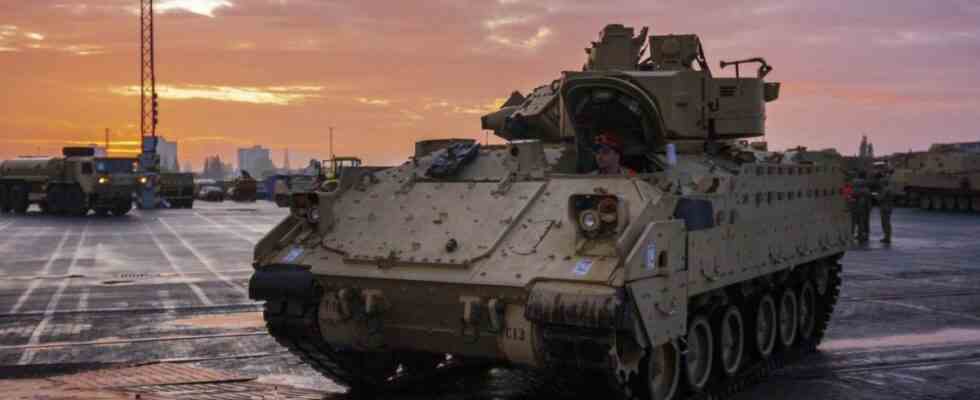For a long time, the US and NATO partners were reluctant to send heavy weapons to Ukraine. In the early stages of the war, many Western military and officials believed that Kyiv would fall quickly, making it uneconomic to ship heavy weapons. Learning to operate complex weapon systems also takes time, which Ukraine seemed to lack. And the risk of the arms falling into Russia’s hands seemed too great to many.
That has changed fundamentally. Ukraine crushed Russia before Kyiv. The NATO countries, especially the USA, which coordinate the shipments, are now massively expanding the delivery of heavy weapons. Up to now it was mostly lighter, defensive weapon systems such as shoulder-launched anti-tank missiles, radar installations or anti-aircraft guns, but now the focus is on offensive and heavier systems. Ukraine is to be upgraded for the second phase of the war, the looming war of attrition in the southeast of the country that may last for months. As good as that is possible now that the Russian offensive is just starting.
Eight to ten cargo planes full of weapons land every day
According to the American NATO command, eight to ten cargo planes full of weapons and military equipment are currently landing in neighboring Ukrainian countries every day. In addition, there are deliveries by train and truck. The weapons are transported from Poland in particular to the Ukraine and are then supposed to find their way to the front.
It is often difficult to say exactly who supplies which systems. There are new reports almost every day, many countries are silent about the details of the arms deliveries, including France, Italy and Germany. The locks for the delivery of heavy weapons opened in early April Czech Republic opened with the announcement, among other things, several dozen tanks of Soviet design T-72 such as BMP-1– hand over armored personnel carriers to Ukraine.
By far the largest supplier of weapons are the USA. The Washington government has pledged or sent $2.5 billion worth of arms to Ukraine since Russia’s war of aggression began. The current delivery includes eleven Wed-17-Helicopters, 200 armored personnel carriers of the type M113300 more switchblade-Kamikaze drones and, most notably, 18 of the 155mm howitzers with 40,000 artillery shells. These are significantly more heavy and technically more complex weapon systems than before. And they should be delivered quickly. The howitzers, for example, would be handed over to Ukraine “very, very soon,” according to Pentagon spokesman John Kirby.
Canada quickly followed suit and also announced the delivery of artillery systems, but without giving details. And the Netherlands, which had deliberately not published any information about arms deliveries in the past few weeks, now announced that they would support Ukraine with heavier weapons such as armored vehicles. The “delivery of additional, heavier material” is also being examined together with allies, Prime Minister Mark Rutte said after a phone call with Ukrainian President Volodymyr Zelenskiy. Belgium joined. Also Norway is considering the delivery of heavy weapons, but has now sent almost 100 anti-aircraft missiles of the type mistral from stocks of the Norwegian military.
And also Great Britain wants to bring more artillery pieces to Ukraine. “This is becoming an artillery conflict,” said British Prime Minister Boris Johnson. Ukraine will need additional guns to help. “That’s what we’re going to give them, in addition to many other forms of support.”
Czech factories repair tanks and military vehicles
Ukraine currently has Russian weapon systems in particular, such as Russian artillery systems with a caliber of 122 and 152 millimeters. But ammunition is already running low. If it runs out, Ukrainian artillery and the systems designed to protect it become useless. That is why, from the Ukrainian point of view, it is so important to quickly get the 155-millimeter guns, which are common in the West, together with their targeting systems, ready for use. Switching to other weapon systems, however, poses a challenge for any army even in peacetime. Ukraine has to manage this on an ongoing basis in the middle of the war. If the enemy gets the opportunity for a major offensive while part of the artillery is not ready for action, the consequences for your own armed forces will be devastating. According to the Pentagon, Ukrainian soldiers should start training on howitzers and radar systems in the coming days outside of Ukraine.
Heavy weapon systems also require logistics, spare parts, maintenance and technicians. Again, there is support for Ukraine. The Czech government has just announced that the country’s defense contractors will repair Ukrainian tanks and other military vehicles. Minor problems or damage would be repaired in Ukraine itself. In addition to repairs, the Czech companies are also to overhaul and restart equipment that has been stored for a longer period of time.

